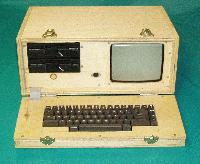

In the early 1980's, I was working with my Mits Altair 8800 as my main computing platform. I had taken on some work with a local company who was using the "new" Motorola 6809 processor. The 6809 was a vastly different architecture, and had many features which were ahead if its time (such as stack relative addressing). In fact, the 6809 still holds the reputation as one of the most powerful general purpose 8-bit processors ever produced.
I very quickly came to really like this machine, and wrote a substantial amount of code for it. I *really* wanted a 6809 machine for my own! After I completed the job, and no longer had access to the 6809 machine, I decided to build one. I wanted it to be portable so that I could carry it to work sites, and I also made the decision to not base it on any existing design - the complete system, hardware and software would all be new.
This document describes the results... This little machine was my companion for many years. Even after it was no longer a main working system, It would often travel with me as a datascope. (It was always the subject of intense scrutiny by airport security people who would invariably A: ask me to turn it on to prove that it was a computer, and B: request that I remove the top so that they could inspect the contents of my "wood box").
Regretably, I do not have any schematics for the machine beyond a couple of very simple block drawings - I literally sat down with the databooks, and designed the circuitry directly into wirewrap wire and protoboard. Amazingly, the machine came to life with almost no rework.
The operating system began as a simple monitor, and grew over the next few months into a fairly powerful command processor that I called "CUBIX".
Compared to the DMF system I wrote for the Altair, CUBIX was quite a bit more evolved. It supported differing disk geometry and drives up to 32M. Where DMF was mainly just a means of reading and writing "blocks" of contiguous sectors on the disk, CUBIX implemented a true allocation scheme and allowed files to be spread over available space. CUBIX also had pseudo multiple directories, character file I/O and many more system services.
At the time I wrote CUBIX, I was working professionally with DEC VAX computers, and some of the "feel" of the VAX user interface can be seen reflected in CUBIX.
This machine was quite significant in my early career. My Micro-C compiler which has become somewhat well known to a fair number of embedded systems programmers was originally written for this machine. Many of my other tools and utiltites also had their beginnings on this little box.
The D6809 was built on a budget - most of the IC's were scrounged from old equipment (the 8K SRAM's were really hard to find at the time).
The 7" monitor came from a local company I worked with - they had received four of them in error from a company in China and when contacted, they decided it was not worth the cost of shipping them back, so they said "keep them".
The keyboard came from a local surplus dealer who had a pile of them new in boxes, with no documentation - I made him a deal that I would figure out the keyboard and give him an information package with the wiring, control commands for the proprietary controller chip and a table of character codes in exchange for several of the keyboards (I must have had a LOT more spare time back then!)
The cabinet: - the cabinet speaks for itself. Good sturdy plywood!
I was quite proud of the D6809 at the time - not many people had designed a complete general purpose hardware/software system, and the results were pretty much what I was aiming for. It proved to be a very useful system, and still runs just as well today (2004) as it did when I first built it.
This package is my way of preserving this system, and sharing it with anyone who is interested in what a completely "homebrew" system was like in the pre-PC days. With the simulator, you can actually boot it up and use it - enjoy!